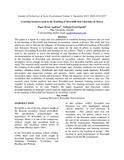Learning resources used in the Teaching of Kiswahili Oral Literature in Kenya

View/
Date
2013-09Author
Agufana, Peace Byrne
Ogechi, Nathan Oyori
Metadata
Show full item recordAbstract
This paper is a report of a study that was undertaken to establish learning resources that are used in the teaching of Kiswahili oral literature in secondary schools in Kenya. The study had four objectives, first to find out the adequacy of learning resources available for teaching of Kiswahili oral literature. Second, to investigate and report on the state of affairs as regards learning resources for teaching Kiswahili oral literature in our schools. Third, to assess methods that are used by the teachers to assess the learning of oral Literature in Kiswahili. Fourth, to make recommendation on strategies which could be employed to improve the learning resources used in the teaching of Kiswahili oral literature in secondary schools. This research adopted descriptive survey design. In total, twenty-seven Form Two Kiswahili teachers took part in the study. The research study reported that most schools had learning resources that could be used in the teaching of Kiswahili oral literature, the notable ones included, textbooks for teachers and students, reference books, chalkboard and chalk materials, teacher made handouts, Kiswahili newspapers and magazines cuttings and pictures, charts, audio tapes and posters, pupil researched topics, notice boards and television. When the frequency of use was checked it was established that availability of learning resources did not automatically lead to their use. The research study further realized that most Kiswahili oral literature learning resources were supplied by schools, students, teachers and parents. Very few learning resources were acquired through donations or on loan. Finally, the paper suggested and discussed various recommendations on strategies which could be employed to improve the learning resources used in the teaching of Kiswahili oral literature in secondary schools.
